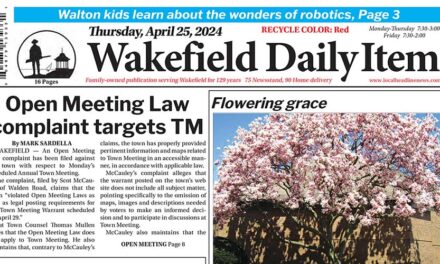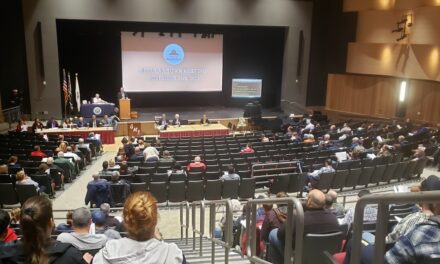Published August 21, 2019
By MARK SARDELLA
WAKEFIELD – If you’ve been wondering if this summer’s ongoing gas line work on Salem Street is related to National Grid’s plans to run a 345kv underground electric power transmission line along the route, the answer is “yes.”
General Manager Pete Dion of the Wakefield Municipal Gas & Light Department confirmed yesterday that the WMGLD’s replacement of gas lines on Salem Street is being done in anticipation of the National Grid transmission line project.
The WMGLD’s goal is to finish the work by November, Dion said, so that National Grid can begin its work next spring. Once National Grid installs its underground transmission line, the energy company will repave the roadway curb to curb. By getting its own work done now, the WMGLD hopes to avoid digging up a newly paved street later.
In the meantime, National Grid has been doing prep work at its substation off Montrose Avenue as well as other preliminary work.
National Grid contractors have already cleared the portion of the MBTA’s unused right-of-way between Bennett Street and Salem Street in preparation for that portion of the transmission line work.

GAS LINE WORK has been ongoing this summer along Salem Street. The Wakefield Municipal Gas & Light Department hopes to complete the work by November so that National Grid can begin work on its underground transmission line project in the spring. (Mark Sardella Photo)
That work included selective tree removal and pruning of the MBTA right of way, test pit work to confirm subsurface conditions, removal of abandoned appliances, machinery, stacks of rails and ties, piles of asphalt and general debris discarded over the years. Unused rail and ties were also removed.
On Feb. 28, 2018, the Massachusetts Energy Facilities Siting Board (EFSB) issued its final approval for the joint National Grid/Eversource Woburn to Wakefield underground transmission line. The line will run from the Eversource Substation in Woburn, through Winchester and Stoneham before entering Wakefield. In Wakefield, the 3.5-mile route would come down Albion Street and Broadway, cross North Avenue and then follow the abandoned railroad bed for approximately one mile, running across Bennett Street, Richardson Street and Water Street. The line would continue along the railroad bed before turning down Salem Street to Montrose Avenue and up the access road to the National Grid Substation.
In its 160-page decision, the Siting Board found that “additional energy resources are needed to maintain a reliable supply of electricity within the Greater Boston Area.” The Siting Board further found that the proposed project “is superior to the other alternatives identified with respect to providing a reliable energy supply for the Commonwealth with minimum impact on the environment at the lowest possible cost.”
The towns of Stoneham and Winchester immediately appealed the EFSB decision to the Supreme Judicial Court. Stoneham has since settled with Eversource, ending its appeal.
Dion said yesterday that it appears that most of the remaining issues under appeal either have been resolved or are close to resolution. He indicated that the WMGLD was moving ahead now with its own work on Salem Street to ensure that there is time to complete the gas line work before National Grid begins its project.
In the wake of the EFSB decision, the Town Council signed a grant of location easement agreement with National Grid in June 2018.
The 12-page agreement sets forth Wakefield’s requirements related to the project to ensure the safety of the public; provide for smooth traffic flow throughout the town; comply with all town regulations; allow for the proper maintenance, repair and replacement of utilities; avoid damage and interruption to utilities; maintain a clean and safe work zone; and provide for speedy completion of the work.
For example, provision #4 of the agreement states that, “All work along the proposed route shall be performed to ensure that existing water, sewer, drain and other utility systems’ condition will not be downgraded and they will continue to provide for uninterrupted service performance, maintenance, repair and replacement into the future after the proposed work in Wakefield is completed.”
The agreement provides the town with the ability to perform testing to ensure that all utilities are functioning properly. In addition, National Grid will fund up to $75,000.00 towards the town’s cost of construction inspection related to water, sewer, trench repair, curbing repair, sidewalk repair, cold plane and repaving, etc.
Another provision requires that all roads impacted by construction will be cold planed and paved (curb to curb) with bituminous concrete after the project is completed. The cold planning and repaving will be at a depth of two inches at National Grid’s expense.
Two-way traffic must be maintained at all times during construction unless otherwise approved in advance by the DPW and Police Department.
The contractor is required to notify all residents along the route of the proposed work in advance. Update notices are also required. Copy of the notices must be provided to the Department of Public Works. The contractor is required to notify businesses of any potential disruption to business parking or deliveries and make a good faith effort to coordinate with businesses to mitigate such disruptions in the project area.
Provisions requiring environmental protection and noise mitigation measures during construction are included in the EFSB approval document.
The Woburn to Wakefield underground transmission line project is a key part of “the Greater Boston and New Hampshire Solution” that was selected in February of 2015 by ISO-NE, New England’s power grid manager, to address an urgent need to strengthen the region’s electric system while balancing consumer cost with community and environmental impact.
In September of 2015, Eversource Energy and National Grid filed a permit application with the Massachusetts Energy Facilities Siting Board for a proposed new underground transmission line to connect Eversource’s Substation in Woburn, MA to National Grid’s Wakefield Junction Substation.
Later that year, they made a presentation to the Board of Selectmen and began meeting with town officials to lay the groundwork for the proposed project, which comes with the promise of certain benefits to the town. Those include a $58.5 million in infrastructure investment, $1.6 million in additional property tax revenue in the first year and a total of $7.3 million in additional tax revenue over the first 5 years after the project is built.
But the project hasn’t always enjoyed a smooth ride. Opposition came out in force at a public hearing in November of 2017. Some residents claimed that they were not properly informed of the project. Others were concerned about electromagnetic fields (EMFs) from electrical transmission cables. Some epidemiological studies have suggested a correlation between proximity to transmission line EMFs and certain types of cancer, although other studies have found no correlation.
To address the EMF concerns, the town retained Dr. Robert Kavet to assess the risk of the Wakefield portion of the transmission line. Kavet had been involved with researching EMF health and safety issues since 1978. He served as co-chair of the Institute for Electrical and Electronic Engineers’ subcommittee on electromagnetic safety concerned with establishing exposure standards. He authored or co-authored about 100 peer-reviewed publications on EMF topics.
In his written report for the town, issued in January of 2018, Dr. Kavet was forthright in expressing his belief that there is no significant health risk from exposure to electromagnetic fields (EMF) at the levels expected from a transmission line like the one proposed in Wakefield.




